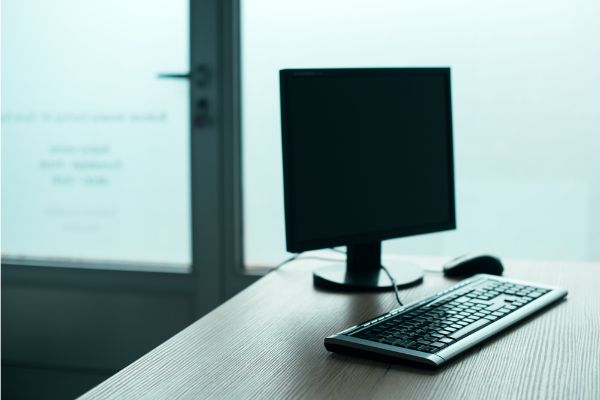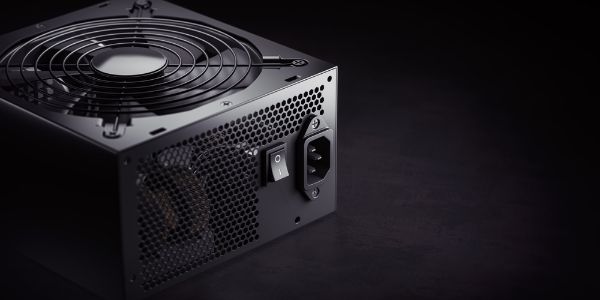Disclaimer: This post may contain affiliate links, meaning we get a small commission if you make a purchase through our links, at no cost to you. For more information, please visit our Disclaimer Page.
Oftentimes, modern computers seem to work so well that we can forget that they have some sensitive electronic components that could run into problems. Each day, we’re ready to boot up our computers and get to work. However, there can be frustrating problems with PCs or laptops that just seem to shut down all on their own, and sometimes they do this right in the middle of something important.
Our article today will go through some of the possible causes of these random shutdowns, and we’ll map out what you might do in order to mitigate this issue.
Table of Contents
Why Does My Computer Keep Shutting Down?
If your computer shuts down randomly just one time, it could be a faulty connection with the power supply unit. Something may have come unplugged or a bit loose. In these cases, just checking all the connections your computer has and making sure things are attached firmly might solve the issue.
However, there are more serious reasons why a PC or laptop might shut down in the middle of tasks, and this is especially true if it is a recurring problem. In our article, we’ll be talking about this issue from the perspective that it is a chronic issue with your computer, so we will take steps to address that.
The first thing to do is run a few tests to narrow the field of possibilities here. The two primary causes for a computer shutting down by itself are issues with at least one part of the hardware, or a software glitch that the PC can’t handle. Within each of these main factors could be several smaller reasons, and there are ways you might be able to figure out what the problem is yourself.
If there are no noticeable physical effects on your computer that could be contributing to this problem, you can find ways to check for software errors first. Physical signs of a hardware issue might include excessive heat from the casing or very loud fans running continuously. We’ll cover these in more detail after we take a look at possible software problems.
How Can I Tell if It’s a Software Problem?
Your computer is great at running many types of software to help you with your daily tasks. In most cases, it’s running a number of programs in the background that you might not even notice.
If it can do all of this with ease, you know your machine is in pretty good shape. However, sometimes a computer runs into software that is buggy or that it can’t handle for another reason. In such cases, it might have what amounts to a bit of “computer brain fog” when it tries to do something.
This inability to run the software properly or bug in the system could cause it to shut itself off if it can’t get past it. You won’t know for sure at first, but there are ways to check if software might be the primary cause of your computer’s woes.
1. In Windows 10, the Event Viewer is a powerful tool that tracks every action your computer takes and can make note of strange exceptions that could be indicative of a problem.
2. To access Event Viewer, you can go to ‘Start’ and search for ‘Event Viewer’ directly from there.
3. Once Event Viewer opens, you can follow a linear path to check for possible issues. Do this by going over to ‘Event Viewer’ on the right-hand side and selecting ‘Windows Logs from the nested menu there.
4. From Windows Logs, look for ‘System’. Instead of clicking on it directly, right-click this entry so that you can select ‘Filter Current Log’.
5. Filtering for the current log can give you an idea of what happened during the last session before your computer shut down.
6. There are a few options you can try, and we can help you look for the most likely error codes that can tell you what happened. Some of the most important numeric codes here are 41, 1074, or 6008.
7. A 41 code indicates the shutdown was unexpected due to a crash. While you might already know this if you were working on it, it’s good to confirm that the system recognizes that it was a crash.
Unlike a 1074, which indicates a manual shutdown or a restart that was supposed to happen. A 6008 can confirm that the shutdown in your previous session was not something the computer expected.
8. To see if software from an update or installation you performed might be the cause, we recommend running a System Restore operation. System Restore can revert your computer to an earlier state before certain updates were applied.
If you know your computer ran fine before a certain date, you can dial it back to this time to see if the issue still persists.
9. Go to ‘Start and search for ‘Recovery’. Click on the appropriate option.
10. When the window pops up, you can choose to ‘Open System Restore’ and follow the appropriate steps to revert your computer to a working state.
How Can I Tell if My PC Is Overheating?
Software glitches happen, but another likely culprit is one of the physical components of your computer just not keeping up with demand. Your PC does a lot of work, and it needs to keep its electronic parts cool to ensure smooth operations. If your computer is overheating, it may just shut itself off randomly because things are too hot to function.
1. If it seems like your CPU is throttling or performing at suboptimal levels, this could be a sign that things are getting too hot inside the case.
2. As mentioned, an excessively noisy fan could point to overheating. It could also mean the fan itself is faulty, and this would contribute to overheating as well.
3. If your system is running sluggishly but not encountering any direct conflicts with software, the components inside might be running too hot to keep things going smoothly.
4. Check the area around your PC. If it is not ventilated properly for good airflow, it could be overheating.
5. There are several apps you can install that are intended to monitor the temps inside your computer and give you readings. These can help you see if things are too hot.
How Do I Know if My Power Supply Is Failing?
No power means no juice for the computer to do its thing, and a faulty or failing power supply could be as likely as overheating. There are a few telltale signs you can look out for in these cases. Because most of these signs actually look the same as overheating, we’ll tell you a few of the ways you might be able to test the power supply directly.
1. Check your PSU for external switches and make sure they’re all in the appropriate positions.
2. Look to see if the power cable is connected to both the PSU and the wall socket snugly.
3. If everything seems connected, use a different cable if you have one. Testing with a different cable can help you figure out if it is an issue with the cable or the PSU itself.
4. Check the internal connections, particularly those that attach to peripherals the PC is using.
5. If you have a spare PSU available, you might get a definitive answer by performing a swap test.
6. You can unplug your possibly faulty PSU, connect the secondary one to your motherboard and boot drive, plug it in, and boot things up. If everything seems to work, your PSU could be the main issue here.
How Do I Cool My PC?
Giving your PC some air and letting those parts breathe is one of the main ways you can avoid unexpected shutdowns and other problems. It all starts with the fans.
1. It is a good idea to have at least two fans that can run inside the casing at any given time. You can add more fans to a computer that does some heavy tasks, but two is the good minimum to start with. One of these fans should be focused on air intake to make sure cooler air gets into the PC.
2. You can look into liquid cooling options for the GPU if you want a more in-depth system that is designed to keep things at the right temperature. However, it is important to keep in mind that this is a rather advanced setup, and it is not strictly necessary in many cases.
3. You can go for something in between these options and get an all-in-one or AIO liquid cooling setup. This will also require the use of fans, however.
4. It might not seem likely but you could be working with the wrong kind of case for your rig. Some cases make it a priority to give good airflow to the components and keep things ventilated.
Conclusion
Random shutdowns are never a fun thing, and they are the last thing you want to worry about when working with sensitive data. To avoid these problems, you can weed out software issues that are causing your PC to have hiccups.
Additionally, you have ways to check for failing components or overheating that may be preventing your computer from running smoothly. Keep in mind that there are ideal temp ranges for most the important parts of a PC, and you want them to run within ranges that are neither too hot nor too cold.


